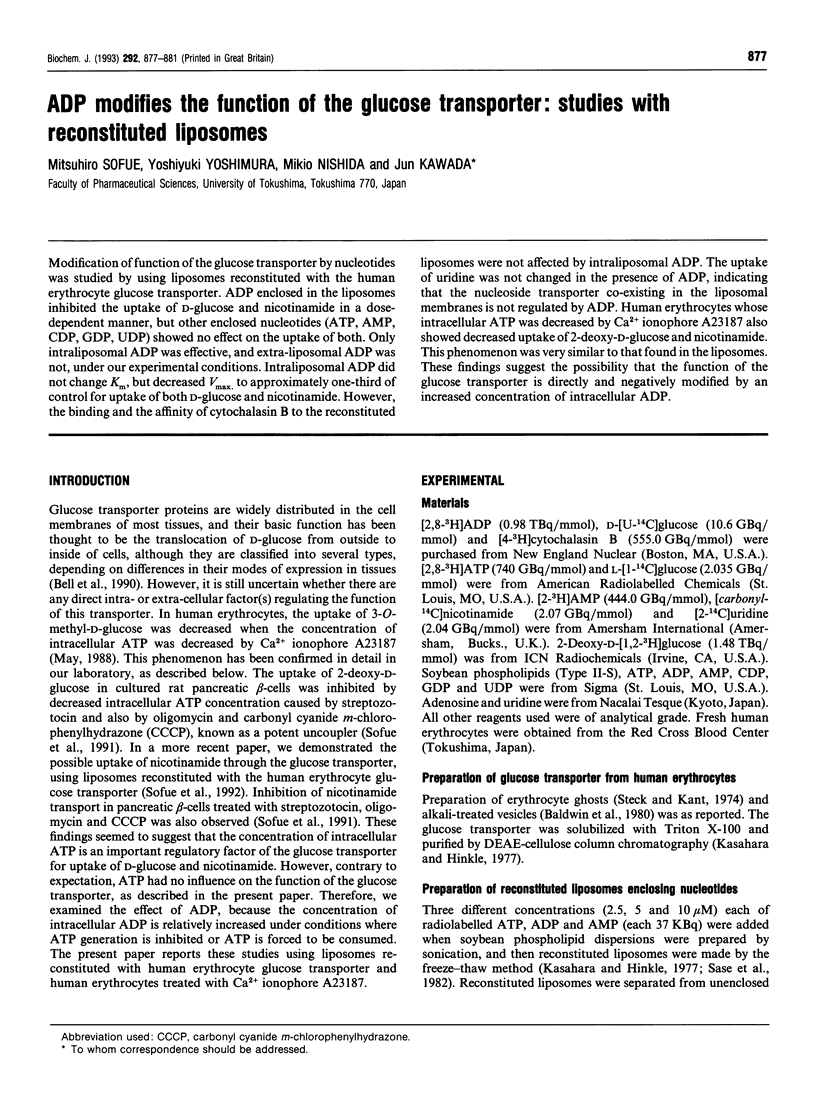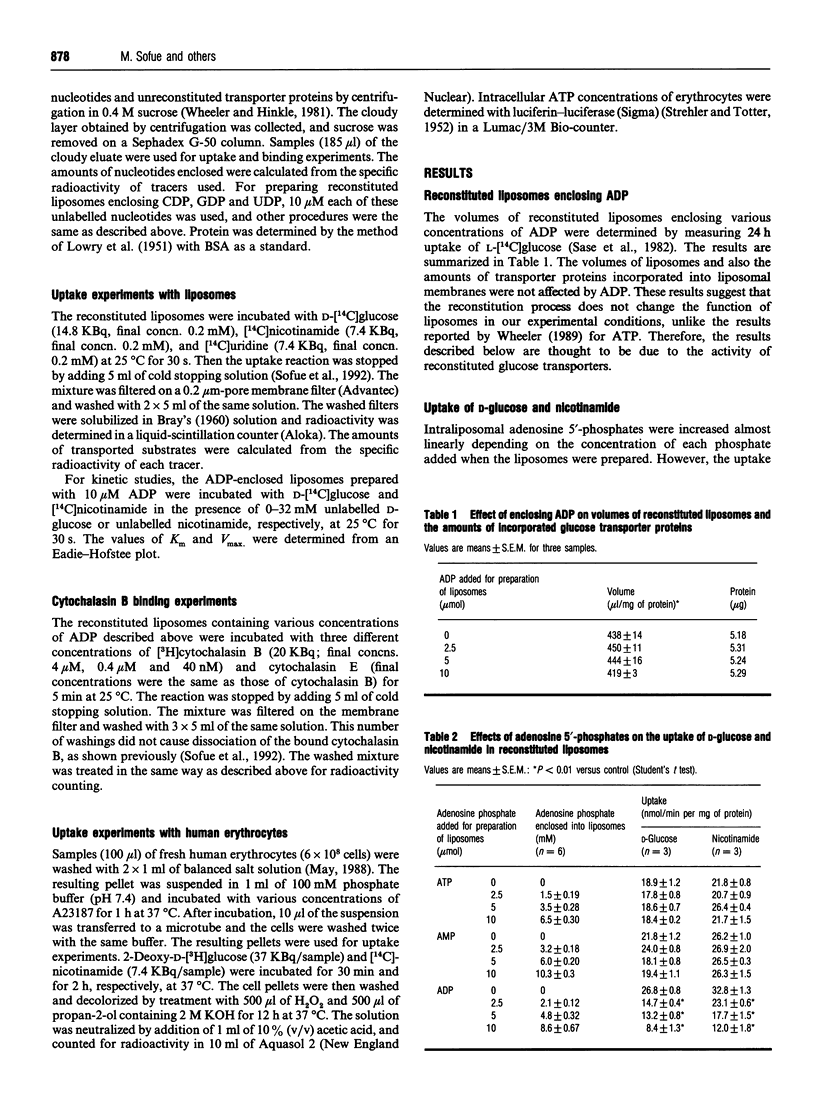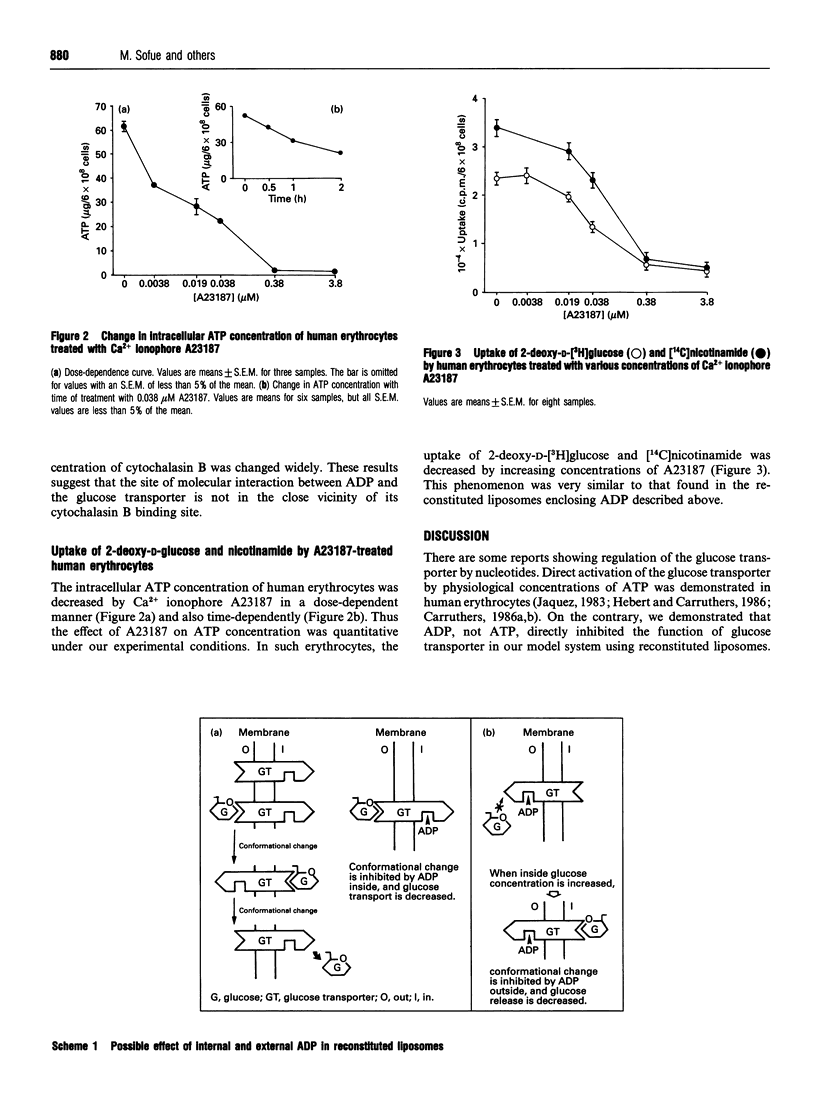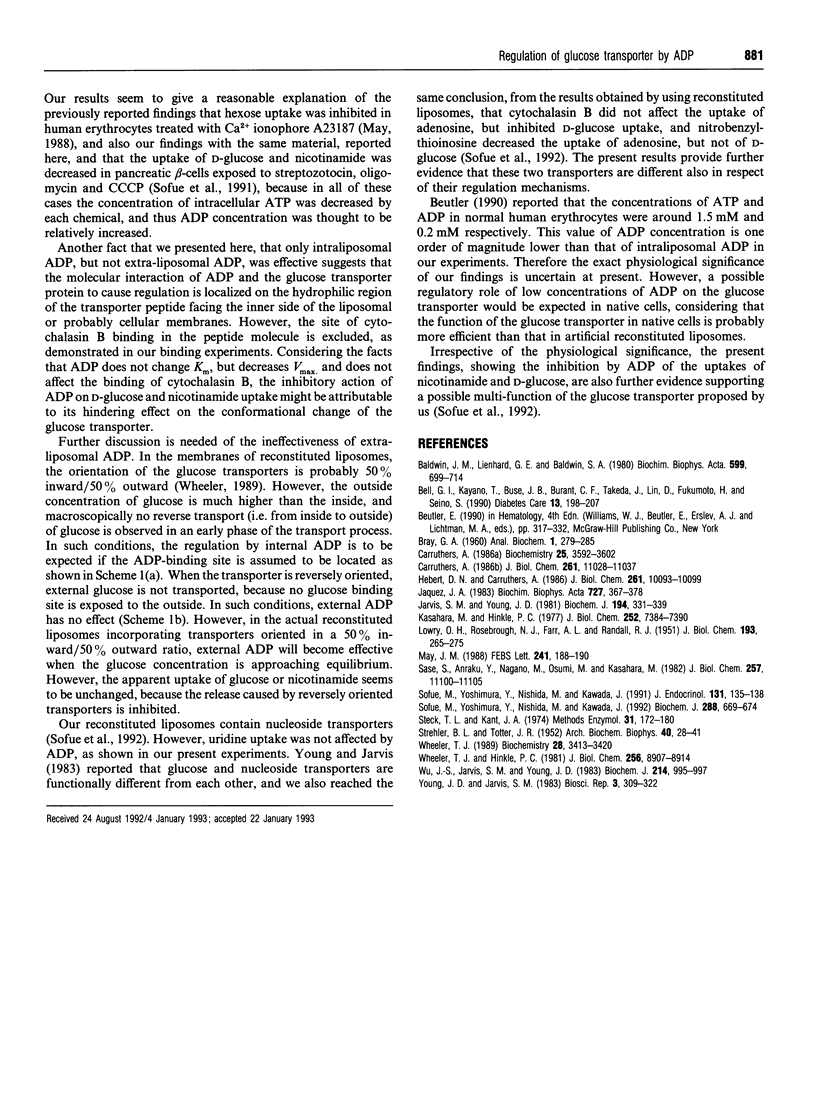Abstract
Modification of function of the glucose transporter by nucleotides was studied by using liposomes reconstituted with the human erythrocyte glucose transporter. ADP enclosed in the liposomes inhibited the uptake of D-glucose and nicotinamide in a dose-dependent manner, but other enclosed nucleotides (ATP, AMP, CDP, GDP, UDP) showed no effect on the uptake of both. Only intraliposomal ADP was effective, and extra-liposomal ADP was not, under our experimental conditions. Intraliposomal ADP did not change Km, but decreased Vmax to approximately one-third of control for uptake of both D-glucose and nicotinamide. However, the binding and the affinity of cytochalasin B to the reconstituted liposomes were not affected by intraliposomal ADP. The uptake of uridine was not changed in the presence of ADP, indicating that the nucleoside transporter co-existing in the liposomal membranes is not regulated by ADP. Human erythrocytes whose intracellular ATP was decreased by Ca2+ ionophore A23187 also showed decreased uptake of 2-deoxy-D-glucose and nicotinamide. This phenomenon was very similar to that found in the liposomes. These findings suggest the possibility that the function of the glucose transporter is directly and negatively modified by an increased concentration of intracellular ADP.
Full text
PDF




Selected References
These references are in PubMed. This may not be the complete list of references from this article.
- Baldwin J. M., Lienhard G. E., Baldwin S. A. The monosaccharide transport system of the human erythrocyte. Orientation upon reconstitution. Biochim Biophys Acta. 1980 Jul;599(2):699–714. doi: 10.1016/0005-2736(80)90211-4. [DOI] [PubMed] [Google Scholar]
- Bell G. I., Kayano T., Buse J. B., Burant C. F., Takeda J., Lin D., Fukumoto H., Seino S. Molecular biology of mammalian glucose transporters. Diabetes Care. 1990 Mar;13(3):198–208. doi: 10.2337/diacare.13.3.198. [DOI] [PubMed] [Google Scholar]
- Carruthers A. ATP regulation of the human red cell sugar transporter. J Biol Chem. 1986 Aug 25;261(24):11028–11037. [PubMed] [Google Scholar]
- Carruthers A. Anomalous asymmetric kinetics of human red cell hexose transfer: role of cytosolic adenosine 5'-triphosphate. Biochemistry. 1986 Jun 17;25(12):3592–3602. doi: 10.1021/bi00360a018. [DOI] [PubMed] [Google Scholar]
- Hebert D. N., Carruthers A. Direct evidence for ATP modulation of sugar transport in human erythrocyte ghosts. J Biol Chem. 1986 Aug 5;261(22):10093–10099. [PubMed] [Google Scholar]
- Jacquez J. A. Modulation of glucose transport in human red blood cells by ATP. Biochim Biophys Acta. 1983 Jan 19;727(2):367–378. doi: 10.1016/0005-2736(83)90422-4. [DOI] [PubMed] [Google Scholar]
- Jarvis S. M., Young J. D. Extraction and partial purification of the nucleoside-transport system from human erythrocytes based on the assay of nitrobenzylthioinosine-binding activity. Biochem J. 1981 Jan 15;194(1):331–339. doi: 10.1042/bj1940331. [DOI] [PMC free article] [PubMed] [Google Scholar]
- Kasahara M., Hinkle P. C. Reconstitution and purification of the D-glucose transporter from human erythrocytes. J Biol Chem. 1977 Oct 25;252(20):7384–7390. [PubMed] [Google Scholar]
- LOWRY O. H., ROSEBROUGH N. J., FARR A. L., RANDALL R. J. Protein measurement with the Folin phenol reagent. J Biol Chem. 1951 Nov;193(1):265–275. [PubMed] [Google Scholar]
- May J. M. Effects of ATP depletion on the mechanism of hexose transport in intact human erythrocytes. FEBS Lett. 1988 Dec 5;241(1-2):188–190. doi: 10.1016/0014-5793(88)81058-5. [DOI] [PubMed] [Google Scholar]
- STREHLER B. L., TOTTER J. R. Firefly luminescence in the study of energy transfer mechanisms. I. Substrate and enzyme determination. Arch Biochem Biophys. 1952 Sep;40(1):28–41. doi: 10.1016/0003-9861(52)90070-2. [DOI] [PubMed] [Google Scholar]
- Sase S., Anraku Y., Nagano M., Osumi M., Kasahara M. Random distribution of the glucose transporter of human erythrocytes in reconstituted liposomes. J Biol Chem. 1982 Sep 25;257(18):11100–11105. [PubMed] [Google Scholar]
- Sofue M., Yoshimura Y., Nishida M., Kawada J. Possible multifunction of glucose transporter. Transport of nicotinamide by reconstituted liposomes. Biochem J. 1992 Dec 1;288(Pt 2):669–674. doi: 10.1042/bj2880669. [DOI] [PMC free article] [PubMed] [Google Scholar]
- Sofue M., Yoshimura Y., Nishida M., Kawada J. Uptake of nicotinamide by rat pancreatic beta cells with regard to streptozotocin action. J Endocrinol. 1991 Oct;131(1):135–138. doi: 10.1677/joe.0.1310135. [DOI] [PubMed] [Google Scholar]
- Steck T. L., Kant J. A. Preparation of impermeable ghosts and inside-out vesicles from human erythrocyte membranes. Methods Enzymol. 1974;31:172–180. doi: 10.1016/0076-6879(74)31019-1. [DOI] [PubMed] [Google Scholar]
- Wheeler T. J. ATP does not regulate the reconstituted glucose transporter. Biochemistry. 1989 Apr 18;28(8):3413–3420. doi: 10.1021/bi00434a041. [DOI] [PubMed] [Google Scholar]
- Wheeler T. J., Hinkle P. C. Kinetic properties of the reconstituted glucose transporter from human erythrocytes. J Biol Chem. 1981 Sep 10;256(17):8907–8914. [PubMed] [Google Scholar]
- Wu J. S., Jarvis S. M., Young J. D. The human erythrocyte nucleoside and glucose transporters are both band 4.5 membrane polypeptides. Biochem J. 1983 Sep 15;214(3):995–997. doi: 10.1042/bj2140995. [DOI] [PMC free article] [PubMed] [Google Scholar]
- Young J. D., Jarvis S. M. Nucleoside transport in animal cells. Biosci Rep. 1983 Apr;3(4):309–322. doi: 10.1007/BF01122895. [DOI] [PubMed] [Google Scholar]


